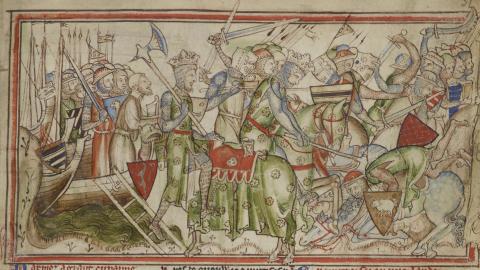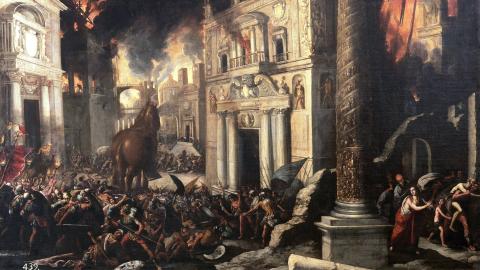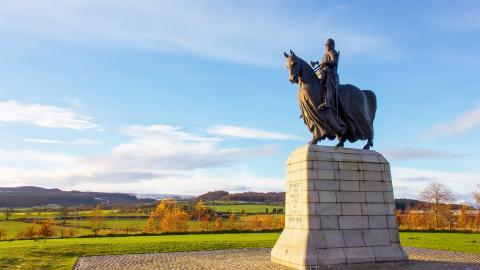Race To Victory: Episode guide
Episode 1 - Mortal Peril
8th May, 1945. Celebrations erupt across the world as the war ends in Europe. It is VE Day: Victory in Europe Day. But it has been a long, hard race to get here…and war is still raging in the Pacific.
In 1938, British Prime Minister, Neville Chamberlain, was determined to keep the peace in Europe. By signing the Munich Agreement with Adolf Hitler, he believed he would prevent war with Germany and bring “peace in our time”. The peace Chamberlain thought he’d guaranteed, however, was shattered by Hitler’s invasion of Poland on 1st September, 1939. Over the next eight months, the Nazi’s continued to sweep across Europe, with Norway, Holland, Belgium and France falling under Hitler’s control.
Chamberlain declared war on Germany on 3rd September. His agreement had not saved Europe from the Nazi’s. As Europe fell, country after country, so did Chamberlain’s popularity causing a vote of no confidence and his resignation. At the outbreak of war Chamberlain had invited Winston Churchill to join the war cabinet as the First Lord of the Admiralty. Could this be the man to lead Britain to victory in the Second World War?
In the United States, President Franklin D. Roosevelt announced to his largely isolationist electorate: “This nation will remain a neutral nation”. Over the next two years the question would be asked with increasing desperation as to when and whether Roosevelt would listen to Churchill’s entreaties and enter the war. On 13th May 1940, Churchill made his first speech as Prime Minister before the House of Commons. Prime Minister Churchill famously declared “I have nothing to offer but blood, toil, tears, and sweat”. Churchill wasted no time in showing his true grit - after just 16 days as Prime Minister he spearheaded the evacuation of Dunkirk and led the country to victory over the Luftwaffe in the Battle of Britain.
Meanwhile Hitler had entered into a secret peace agreement with Stalin and the Soviet Union. Earlier in 1939, Stalin had attempted to make an alliance with Britain and France, but he distrusted them and felt he would be safer siding with Hitler. This would be a grave mistake. On June 22, 1941, Nazi Germany and its Axis allies began a massive surprise invasion of the Soviet Union - Operation Barbarossa. Three and a half million Nazi troops stormed across the Russian border. Catching the Soviets by surprise, the Germans were initially unstoppable. Fortunately they were slowed by a devastating Russian winter. The battle on the Eastern Front was far from over.
Episode 2 - An Unholy Alliance
7:48am on 7th December, 1941. The US naval base at Pearl Harbor in Hawaii is attacked by 350 Japanese planes. They sink four American battleships - half the US fleet. In just two hours, they also destroy 188 aircraft and kill more than 2,000 Americans.
The majority of Americans did not want to be caught up in another world war. Roosevelt had won a third presidential campaign in 1940 promising 'Your boys are not going to be sent into any foreign wars.' Throughout 1940 and 1941, Roosevelt and Churchill had worked together to win victory over
Nazi Germany, whilst maintaining American neutrality. As Churchill grew more frustrated that the US would not actually join the war, Roosevelt negotiated the ‘Lend-Lease Act’ supplying Britain with tanks, aircraft, ships, weapons, clothing and food. In August 1941, Churchill crossed the Atlantic Ocean and secretly met Roosevelt face to face for the first time in Newfoundland. The meeting resulted in the Atlantic Charter being signed, setting out the British and US goals for the period following the war. Churchill hoped that America would now finally join the fight. But he was wrong.
Meanwhile in Eastern Europe, the Molotov-Ribbentrop pact between the Soviet Union and Germany was reduced to dust, when three million Nazi troops rolled across the Russian border in June 1941. The German forces headed towards Moscow, then changed tack - closing in on Leningrad which they surrounded, laying siege to the city for two and a half years. Stalin was desperately in need of new allies.
Then on 7th December, 1941, the US naval base Pearl Harbor was unexpectedly attacked by the Japanese, catapulting America into the war and bringing the conflict into the Pacific.
On 8th December, America declared war on Japan. And three days later, the US also declared war on Germany and Italy. Churchill finally had what he wanted.
This mutual desire to defeat the fascist powers at all costs brought Churchill, Roosevelt and Stalin together in an alliance, despite their vastly different ideologies. On New Year’s Day 1942, representatives of Britain, the US and USSR signed the United Nations Declaration, pledging to join hands to defeat the Axis powers. The ‘Big Three’ was born.
Episode 3: Victory At Any Cost
On 13th April 1943, mass graves filled with the corpses of more than 4,000 Polish military officers are discovered by German forces. We now know that these were not the victims of Hitler’s Holocaust but evidence of the Soviet-Union’s brutal takeover of Poland in 1939. However, Stalin denies any involvement, claiming the Nazi’s have killed the victims themselves.
The USSR was taking the brunt of the German attack in the East. The Siege of Leningrad was causing hundreds of thousands of Russians to starve to death. The siege lasted nearly 900 days, whilst Nazi shelling and bombing of the city continued. More than 750,000 people died, between a quarter and a third of Leningrad's pre-siege population. It was the greatest loss of life experienced by a modern city.
In June 1940, the North African Campaign had begun and the fight between the Allies and Axis Powers there would last for three years. In 1942, thousands of British and American forces landed on the west coast of North Africa, leading to the surrender of all remaining Axis troops in Tunisia in May 1943 and successfully ending Fascist control of any part of Africa.
On the Eastern Front, Soviet forces had been fighting the Nazis not only in Leningrad but also in Stalingrad, resulting in a huge loss of life. Stalingrad is considered to be the greatest and most brutal battles of the entire conflict. It took five months of fighting before Soviet forces were able to drive the Germans out of the city.
In the Pacific, American forces entered into long difficult battles against Japan with the Battle of Guadalcanal and the Battle of Midway, putting a huge strain on their resources and men, before emerging victorious.
These successes were all taking the Allies in the right direction for a final victory. But what would the response of Roosevelt and Churchill be to the horrific revelations of the Katyn Massacre? And how would this affect their alliance with Stalin?
Episode 4: Tehran Sit-Down
Tehran, 29th November 1943. The Big Three are meeting for the first time. The three leaders seem to be in full support of one another, but they also have their own interests at heart. So how will they work together at this historic conference?
After Hitler was defeated in the Battle of Stalingrad in July 1943, the Nazi leader launched Operation Citadel, which became known as the Battle of Kursk. On 5th July 1943, one of the largest tank battles in history began. Despite a successful start, the Germans struggled to break through the endless numbers of Soviet troops.
Meanwhile, in the Mediterranean, a joint force of British and American soldiers commenced their invasion of Sicily on 9th July 1943. After the successes of the North African campaign. a rivalry had begun between the British General, Bernard Montgomery, and US General, George Patton. Both wanted the glory of reaching the capital of Sicily first, sparking the ‘Race to Messina’ with Patton eventually making it into the city just hours before Montgomery.
At the top, Roosevelt was keen to develop his relationship with Stalin and began pushing for a face to face conference between the Big Three. A number of locations were suggested, but Stalin was paranoid about his personal security and hated travelling outside the Soviet Union.
Eventually, Stalin agreed to travel to the Iranian capital, Tehran, so the Big Three could meet for the first time. But the conference did not get off to the best start. Soviet intelligence apparently identified a German plot to assassinate the three men. Roosevelt ended up staying in the Soviet embassy with Stalin, giving them both a fantastic opportunity to discuss the war situation in private - which did not please Churchill. The three personalities had never been in the same room together before and - aside from their joint aim of defeating Hitler - all had their own agendas. Stalin above all wanted a second front in France.
Churchill felt the British weren’t ready. Eventually, Roosevelt Sided with Stalin and broke the deadlock. Stalin’s much anticipated “Western Front” would finally open.
Nerves grew as the day approached, exacerbated by bad weather which delayed the invasion. But finally, on June 6th, Eisenhower gave the green light: the Allies would now begin Operation Overlord.
D-Day and Beyond
6th June 1944 - D Day. More than 156,000 British, American, and Canadian soldiers are transported across the English Channel, in the largest seaborne invasion ever attempted.
After years of pressure from Stalin, Churchill has finally agreed to open a second front in Europe and send Allied troops to liberate occupied France. From there, they will fight their way across to Germany and – with the Red Army, advancing from the East - finally bring down Hitler’s Fascist Empire.
And yet just three months later, the Big Three’s optimism will turn to despair, as the allies' attempt to bulldoze their way as quickly as possible across Europe, comes to a grinding halt.
How did the operation that promised to end the war by Christmas, turn into such a huge failure?
On 6th June, 1944, Allied troops landed on five beaches along a 50-mile coastline in Normandy. By 11th June, the beaches were fully secured and more than 326,000 troops, 100,000 tons of equipment and 50,000 vehicles had arrived in France. The Germans had been caught by surprise and the Allied troops began to advance through the country, liberating Paris in August 1944.
After the success of D-Day, the Allies were sure that victory could be achieved by Christmas. But, this confidence plummeted after a series of military failures. Operation Market Garden - spearheaded by General Montgomery in September 1944- was the largest air operation in history, dropping allied troops into the Nazi-occupied Netherlands and securing territory and bridges in and around the towns of Eindhoven, Nijmegen and Arnhem. The Allies' desperate attempt to secure bridges over the Rhine and liberate the Netherlands and Belgium failed, leaving behind more than 17,000 missing or dead Allied soldiers and thousands of dead Dutch civilians.
After Montgomery’s disastrous military choices there were more unfortunate decisions made by American Generals in the Battle of Hurtgen Forest. Having falsely believed there would be few German troops in the area, the US became embroiled in a grinding battle that became known as ‘The Death Factory’ by American soldiers. They would not break through German positions until February 1945.
In December 1944, Hitler launched his last major offensive against the allies - the infamous Battle of the Bulge - which Churchill described as “the greatest American battle of the war”. After six weeks of savage fighting in freezing weather in the Ardennes Forest, Belgium, victory finally came to the Allies. Meanwhile the Soviet Army was rapidly advancing on Poland and Germany from the East, and began liberating Nazi concentration camps. On January 27, 1945, the Soviet Army entered Auschwitz - the largest of the Nazi concentration camps - and liberated more than 7,000 of the remaining prisoners, most of whom were Jews. It is now estimated that at least 1.3 million people were deported to Auschwitz between 1940 and 1945.
The allies were nearly at the German borders - the Race to Victory was entering its final stages.
Episode 6: Race to Berlin
It is February 1945 and the Allies can almost taste victory. They agree to meet to decide what the future will look like after the war finally comes to an end. And so “The Big Three” come face to face for the second, and last, time in the seaside town of Yalta.
Stalin was at a distinct advantage at Yalta. His Red Army was just 50 miles from Berlin. He was now well-positioned to politically and militarily outflank Churchill and Roosevelt, who was extremely unwell. It was agreed that after Germany’s defeat, the country would be divided into four post-war occupation zones, controlled by US, British, French and Soviet military forces. But Stalin also announced that the Soviet Union would not return the territory in Poland that it had annexed in 1939, nor meet the demands of the Polish government-in-exile based in London. His concession was that Soviet forces would join the Allies in the war against Japan, but only two to three months after Germany’s surrender. Churchill and Roosevelt had little choice but to agree.
The Allies were now in the final race to take Berlin. British and American troops had agreed to link up with their Soviet counterparts. But Stalin reneged on this promise. He was determined to get to the city first. Not only would capturing Berlin have symbolic significance, but the city was also rumoured to house the German nuclear programme. Unaware at this point of America’s advanced nuclear programme, was Stalin trying to grab this valuable information before his Allies?
On 16th April 1945, the Red Army encircled Berlin, gradually taking over the entire city. The Russians had won the race to the German capital. On 7th May 1945, Germany signed an unconditional surrender. But as this victory was celebrated across Europe on 8th May, Japan still needed to be defeated. After a historic four terms in office, Roosevelt died on April 12th, 1945, without seeing Europe liberated. His successor Harry Truman was left with the decision of whether or not to use the atomic bomb to end the war with Japan. On 6th August 1945, the US dropped the first nuclear bomb on Hiroshima and a second on Nagasaki on 9th August. Japan's surrender was swift, issuing a statement to the allies accepting the allies’ terms the following day.
So who had won the race to victory? Back in Europe, Stalin was imposing Soviet control on the countries he had liberated from the Nazis, bringing vast portions of Eastern Europe under Communist rule. Had Stalin succeeded in convincing his allies to trust him, while never trusting them at all? No longer united by a common cause would the Allies be able to continue to work together? With the Race to the Victory won, the three very different ideologies of capitalism, imperialism and communism looked set to clash once more.
Despite the years of alliance and apparent friendship between these major powers, it seems another war, the Cold War, is just around the corner.















